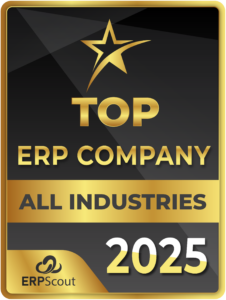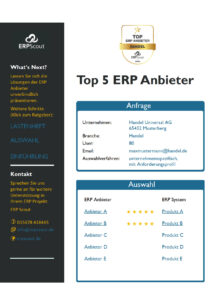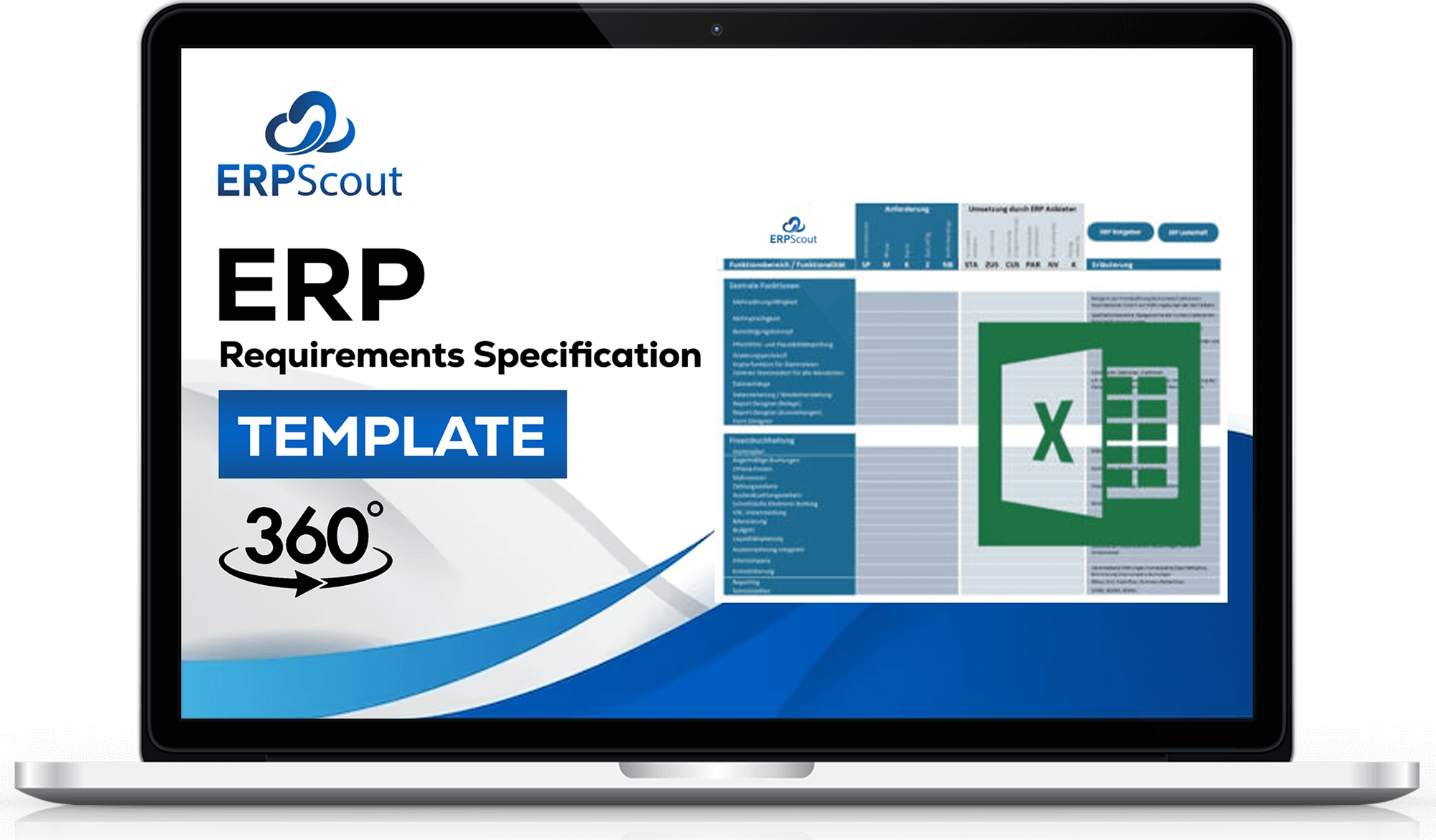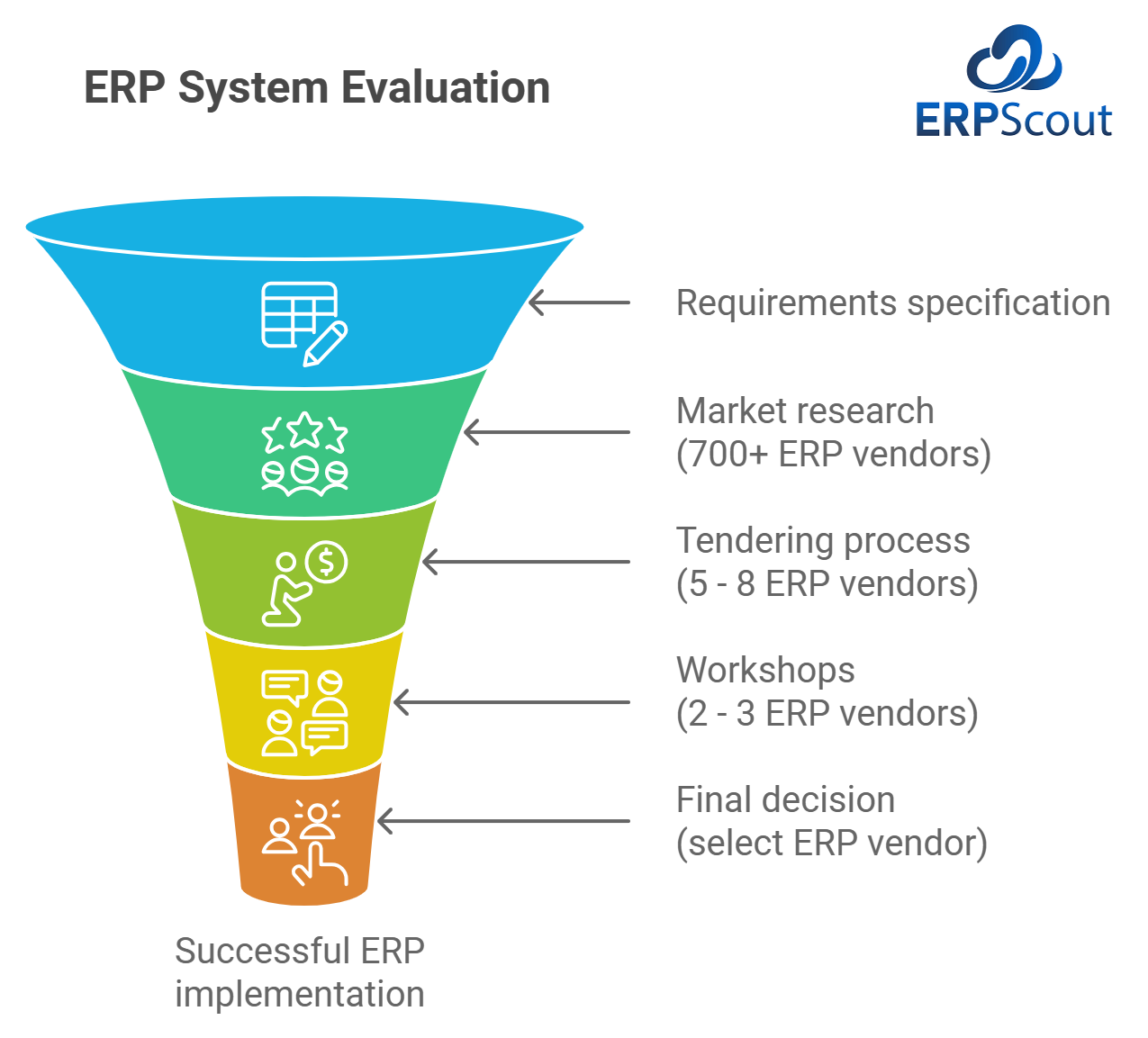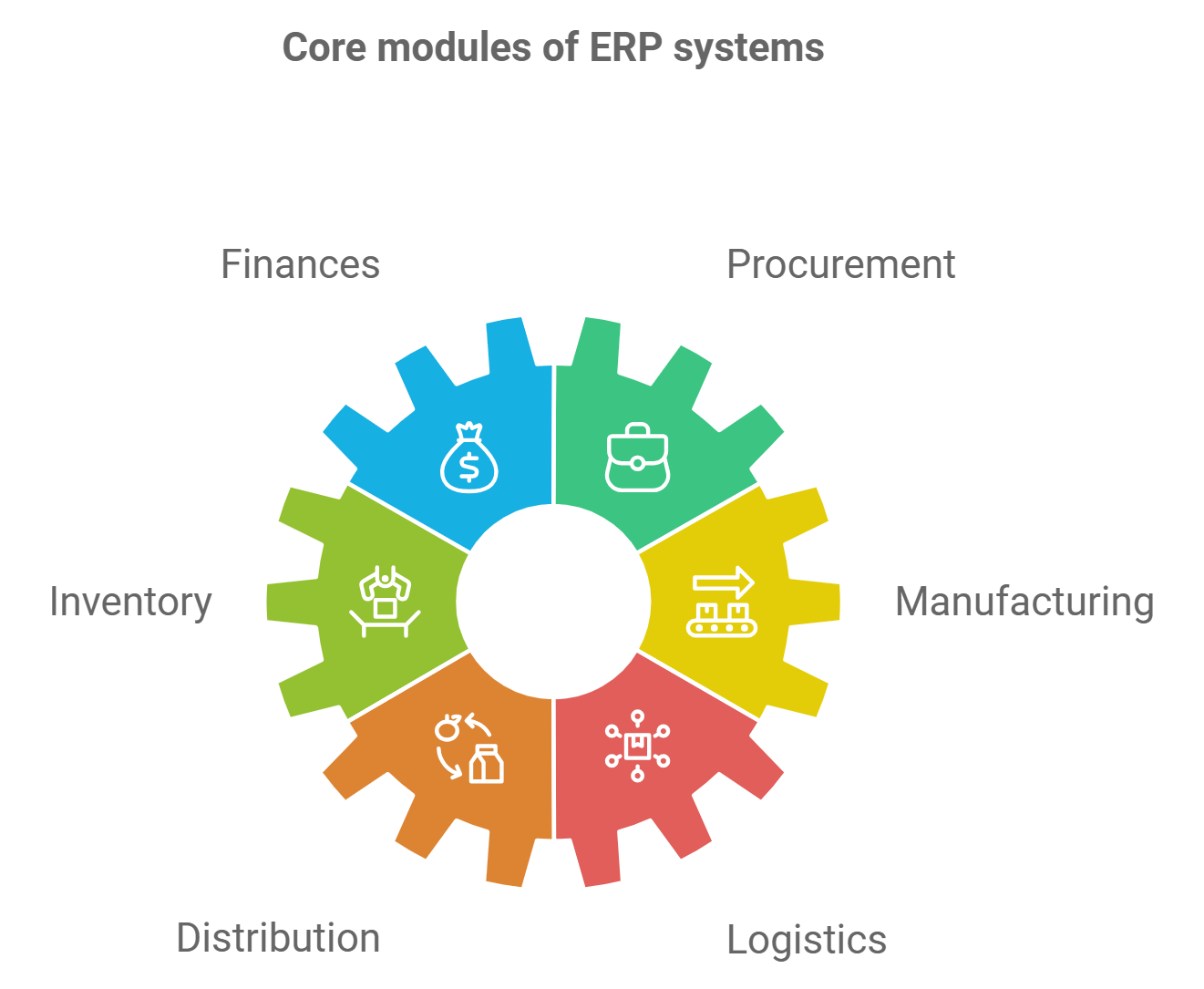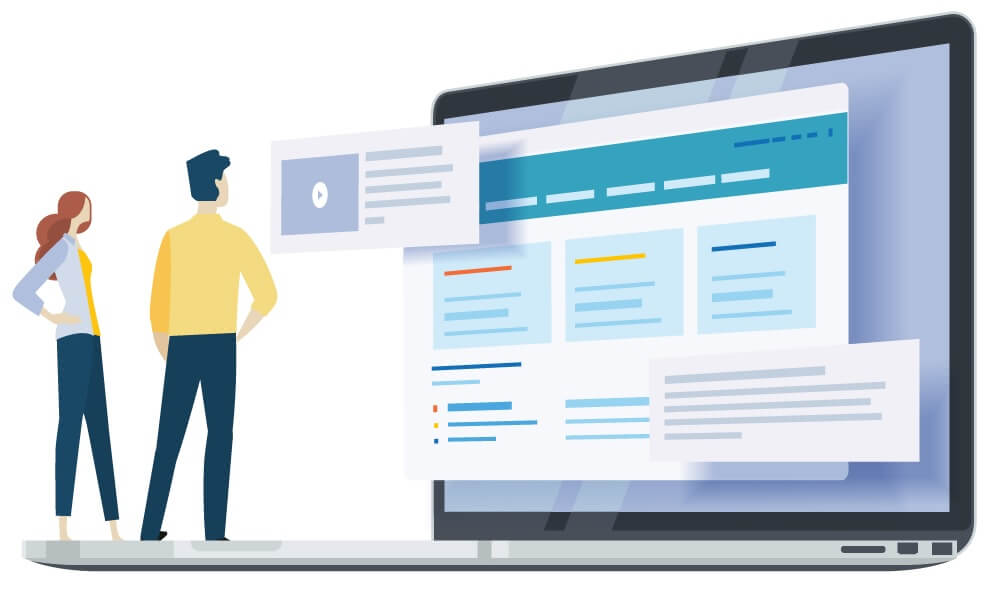What are the advantages ERP software?
The most important advantages of ERP systems are the following:
- Integration: Connecting all of the company’s business units in a common software, which enables seamless collaboration across different locations, even vertically.
- Standardization: Standardized and optimized processes in all departments and at all locations
- Transparency: “Where do we stand?” Overview of all relevant key performance indicators of the company at any time and from anywhere. This is the “cockpit” feature, so to speak.
- Increase profitability : reduce costs and increase sales and revenue
- Increase productivity
- Secure competitive advantages
- Tapping into new business areas and opportunities
- Digitization
- Implementing legal requirements
The ERP Trend Report 2020 from the Center for Enterprise Research at the University of Potsdam has evaluated data on over 1800 ERP projects in which more than 300 different ERP systems are used. Among other things, the advantages for the implementation of ERP projects were evaluated. According to this study, the most important advantages of ERP software in terms of priority are (1) the optimization of business processes, (2) up-to-date data, (3) a uniform integrated IT landscape, (4) consistency, (5) increased efficiency, (6) efficient order processing and (7) transparency.
“If you don’t know the harbor you want to sail into, no wind is right for you.”
The more precisely the goals of an ERP implementation project are set, the easier it is to monitor its success:
- Increase sales by 20% (with existing resources)
- Increase profit by 15%
- Reduce production costs by 10%
- Reduce warehouse throughput time by one day
- Reduce order throughput time by 30%
- Digitize incoming documents and optimize workflow
- Connect new location and integrate seamlessly into processes
- Integrating B2B and B2C e-commerce
What are common reasons for a new ERP system?
Didn’t we just talk about the advantages and goals ? Correct. But the reasons why a company initiates a new ERP project in the first place can also be of a different nature:
- No ERP system has been used to date, but the company has now reached a size that makes this necessary
- The previous ERP software is outdated and may no longer be maintained
- The maintenance costs of the current solution are very high, for example due to individual programming. A new standard solution is therefore to be implemented.
Sometimes companies are actually forced to change their ERP system because the previous solution is no longer being maintained. This can happen if the ERP software manufacturer or ERP implementation partner has gone bankrupt or ceased further development of the product . Or it may be an in-house developed solution that can or should no longer be maintained. If technical or legal framework conditions change, new ERP software must be implemented. Many companies were affected by the “year 2000” problem (“millennium bug”) and tax adjustments may also generate high costs for some ERP systems.
However, anyone who only implements new ERP software because the previous solution is outdated or because everything was previously done with Outlook, Word and Excel without clearly defining the goals of the ERP implementation will not be satisfied later. Why? If project goals are not clearly defined, they will of course not be achieved. Therefore, make sure that your ERP project does not degenerate into a mere “Excel replacement project“. In the projects we have supported, it has often been a matter of implementing processes into the ERP system that were previously somehow mapped using Excel. This is also a legitimate reason for a project, but the objective must be more specific than simply “replacing Excel”. Transparency, profitability and productivity are not random by-products of business decisions. That is why there is a clear distinction between the reasons for an ERP project and the goals to be achieved goals.
What are the phases of an ERP project?
The process of every ERP project is divided into the following three phases:
- Evaluation (see ERP system evaluation guide)
- Implementation (see ERP implementation guide)
- Optimization
Each of these phases consists of several individual steps, which are explained in more detail in our special guides.
How long does an ERP project take?
An ERP project takes an average of 8 – 14 months. The implementation time for cloud ERP software is generally shorter than for on-premise variants. Some ERP vendors advertise a possible project duration of just 3 months for the implementation phase, while at the same time larger customers report that their project has often taken 18 months or more.
Just as the cost of an ERP implementation depends on many factors, so does the duration of an ERP project. An ERP project consists of several phases, whereby the ERP system evaluation phase can take almost as much time as the ERP implementation phase. A sporty project plan often leads to frustration. It is better to plan your ERP project generously in terms of time.
Why do ERP implementations fail?

“This is worse than Brexit, Trump and the trade war” was the headline in the Frankfurter Allgemeine Zeitung. Liqui-Moly CEO Ernst Prost is fed up after the failed ERP project in his company: “I would never have thought that a software changeover could cause an entire company to skid so badly.” The profits of the motor oil specialist from Germany had plummeted by 30 percent.
Unfortunately, this is not an isolated case. “Lidl halts multi-million euro SAP project for merchandise management” wrote Computerwoche. Estimates speak of project costs of around 500 million euros that have been wasted. The company is apparently planning to revive its old software. ERP projects have also failed at Deutsche Post DHL and Otto.
It is not necessarily the fault of the ERP software when projects fail. In most cases, several factors come together to create a domino effect. In our experience, these are the most common reasons why ERP projects are not successful:
1. Team and management
The success of an ERP project depends largely on the quality of the work that the project team delivers or can deliver. The team must be set up at the start of the project , i.e. before the objectives and requirements are defined and therefore also before the ERP software is selected. The project manager is required as a moderator and good communicator. His or her focus is on achieving the technical, budgetary and time-related goals set by the management.
The team members concentrate on mapping the business processes in the areas for which they are responsible. Have the most competent employees been selected under this premise and are they really given sufficient time off for the project right from the start?
And the support of the management is very important. Otherwise, the production manager (if he is not part of the project team) has the feeling that the sales manager (if he is the project manager) wants to dictate to him how the production processes should be mapped and optimized. And that, of course, backfires.
“Many stubbornly pursue the path they have chosen, but few the goal”
2. Gaps in the requirements specification
Many companies underestimate the time required and the importance of fully documenting their own requirements in the requirements specification. Unfortunately, smaller companies often have no requirements description at all; at most a few bullet points on a single page that the project manager has just thought of. It is hoped that the ERP implementation partner will carry out a detailed analysis of the requirements – after all, they want to implement the software and achieve the final acceptance and thus the last installment payment. However, if the ERP partner has not fully recorded important processes or business transactions during its analysis and subsequently in its requirements specification, the damage after going live is considerable.
Therefore: Give your project team the time to completely gather your requirements and set them out in the specifications. And do this before you start the ERP system evaluation process . With our “best practice” ERP requirements specification template 360, you can get started right away. If necessary, get external support for this project step.
3. Customizing vs. standard solution
Standard processes in mature ERP systems are based on best practices. Understanding these and adapting company processes to them is often a guarantee for a successful ERP project. Customizing is expensive, can lead to problems in linked processes and is a nuisance with every release, as it can be associated with additional effort and side effects. Users, on the other hand, argue that this particular process is ultimately a special feature of the company without which it would never have become so successful.
” The most damaging sentence in any language is: ‘We’ve always done it this way’ “
Therefore: Check carefully what disadvantages would arise from the use of standard processes.
4. Sloppy testing phase
The project team has already invested a lot of time in the project and then the testing phase begins. This is short because the aim is to get the live system up and running quickly. The test cases have not been prepared in sufficient detail and the key users do not even have enough time to go through the roughly outlined test cases and then document the results. It will go wrong! And that’s what happens when important processes don’t fit exactly after going live.
Top 5 ERP Systems
Determine the top 5 ERP systems for your company with pinpoint accuracy from 700+ vendors – free of charge and without obligation.

Around 500 companies use our efficient services and tools for their ERP software selection – every year.
